How to conduct a water pipe from polypropylene: design basics and installation rules

At the mention of beautification, most have associations with water supply. And this is no coincidence, it is the supply of water to the house that makes our life more comfortable. Traditional methods of arranging a system with laying metal pipes are safely a thing of the past. Today, water pipes made of polyethylene are increasingly being mounted: with their own hands even a novice plumber can assemble such a design. A properly installed system will last more than fifty years, and the cost of its arrangement will be minimal.
Content
Preparatory phase - selection of parts
It is necessary to choose accessories for the water supply taking into account the operating conditions of the parts. The determining factors are the operating pressure of the system and the temperature of the fluid being transported. Polypropylene pipes are available in several versions, each of them is designed to work in certain conditions. They can be distinguished by marking:
- PN10 - supply only cold water;
- PN16 - transportation of cold and hot water;
- PN20 - hot water supply and arrangement of heating systems;
- PN25 - for heating.
If the temperature of the transported liquid exceeds 60 ° C, the polypropylene pipes expand and sag. Therefore, the PN20 and PN25 grades are reinforced with fiberglass or aluminum foil, which is usually not required when installing a water supply system. For these purposes, the first two pipe modifications are selected.
Having picked up the details of the required brand and the desired diameter, carefully inspect the products. A quality pipe at the cut will be round. The wall thickness over the entire diameter remains unchanged. There are no rough spots or sagging. The same can be attributed to fittings. Try to fit the pipe and fitting of the same diameter. Without heating, it should be impossible to do. If this is not so, then you have a clear marriage. Quality parts even after heating are joined with sufficient force.
System Design Features
Self-assembly of water pipes from plastic pipes requires a detailed diagram. If an inexperienced builder takes up the case, it is better to ask for help from those who have already encountered similar works. It is very important to design the pipeline so that it has a minimum number of bends and intersections. It is also important to try to develop a scheme so that the length of the pipeline is the smallest, and it is ergonomic.
We begin the project by selecting a design option. Connecting the main line to various plumbing devices can be performed in a closed or open way.The first option is more complex and will require professional execution and a very accurate calculation. It is assumed that all pipes that will be removed into the wall are made from a single piece, without joints. Connection points must be accessible for inspection and maintenance.
A much simpler option is open wiring. It involves the installation of pipes in vertical planes at the corners of the room, in horizontal - at the floor level. This method is chosen in order to make the layout less noticeable. An open system, in addition to ease of installation, has another important advantage: ease of maintenance and repair. In addition, in the event of a leak, it can always be noticed and eliminated on time. The wiring for water supply can be performed in various ways.
Option # 1 - Serial Wiring
A sequential or, as it is also called, a tee system involves the sequential summing of the pipeline from the main line to the points of water consumption. Two pipes should leave the riser with an introductory locking device: with cold and hot water. With them, using tees, bends are organized to all points of consumption. The main advantages of this method are cost-effectiveness, as the minimum amount of materials is used, and ease of installation.
Among the disadvantages are the dependence of consumer devices on each other. That is, if the polypropylene water supply system is organized in this way, to turn off one device, you will have to shut down the entire system. This negative factor can be neutralized by installing shutoff valves on each branch. In addition, with the simultaneous inclusion of several points, pressure differences are possible. The tee is a fairly large node and it is not always possible to find a suitable place for it in the bathroom.
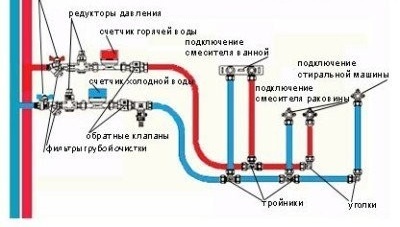
Serial wiring of the water supply system is the most economical option, which will require the least amount of material and minimum cash costs. However, in order to service a single tapping point, the entire system will have to be shut down.
Option # 2 - Parallel or Collector System
Parallel wiring assumes the presence in the design of the collector, a device with a single input and several leads, their number corresponds to the number of water consumption points. Each water intake is connected to an individual outlet. The advantages of such a system are obvious: for maintenance and repair there is no need to turn off the entire system. Water is distributed evenly to all consumption points, therefore, even at the time of pressure drops, all devices receive the same amount of water.
All system control devices are assembled in one place - in the collector cabinet. It is possible to put metering devices or a pressure regulator at the outputs to ensure a given water pressure in a specific plumbing device. Disadvantages - a large number of wiring and, as a consequence, a higher cost of the system, the complexity of installation work.
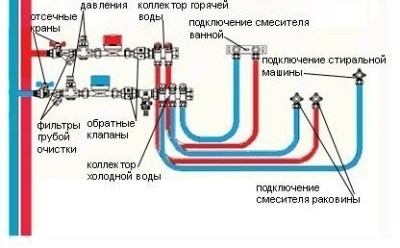
Parallel wiring requires a collector, a device with one input and multiple outputs. Their number corresponds to the number of water consumers. The presence of a collector gives significant advantages to the system
Rules for the installation of polypropylene pipes
Before starting work, referring to the scheme, we cut pipe fragments of the desired length. For work, we use only a special tool. We check the availability of the necessary details. You need to know that special joints are used for pipe joints and transition to a different diameter, for corners and around obstacles - corners, to go around the pipe you need to use a bypass. Tees, caps and crosses are also used. All these fitting models are available in various sizes, so you should carefully study the water supply scheme before buying.
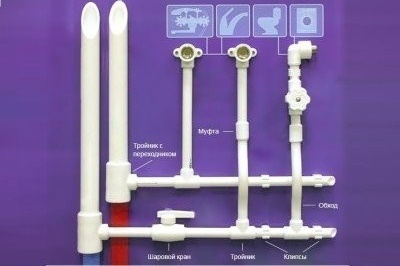
To equip a polypropylene water supply system, not only pipes are used, but also many additional connecting elements called fittings
Clips are used to fix pipes to the wall. They are placed at a distance of 1.5-2 m for straight sections and in places of corner joints. If the pipes lie one above the other, take double clips. Risers are attached with metal clamps with rubber gaskets. The element bends around the pipe, forming a ring. It is twisted with a bolt and nut. Experts recommend installing the rotation of the internal corner of the hot pipeline at a distance of about 3-4 cm from the wall. And the outer corner, on the contrary, is a little closer.
Fragments of polypropylene pipes by welding are connected in the desired order. To do this, clean and degrease the pipe section. Choose nozzles for a soldering iron, just degrease them. Then install the parts in the device and heat up the equipment to 260C. As soon as the lights on the body go out, you can start welding.
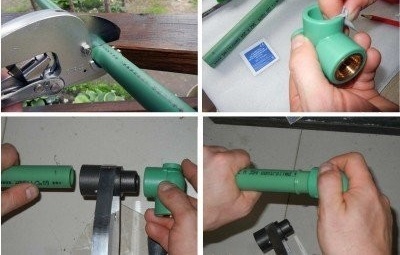
Cutting and joining of polypropylene parts is carried out using special tools. In the absence of the appropriate skill, you should practice a little on pipe trunks before starting work
Pipe and fitting are installed in their intended places until they stop. After waiting for the time to warm up the parts, it is determined by the diameter of the products, they are removed. Then, the fitting and pipe are combined in a quick and accurate movement, pushing it all the way. Rotating elements during the connection process is strictly prohibited. For some time, the heated parts retain plasticity, so they must be fixed until completely cooled. The result is a monolithic durable part.
Practice shows that even an inexperienced plumber can do the installation of a plastic water pipe on his own. You will need to get acquainted with the welding technology and a small skill in the work, which is easy to get by training a little on pipe cuts. A careful study of the instructions and their subsequent accurate implementation guarantees the quality of installation, which will ensure an uninterrupted supply of water.
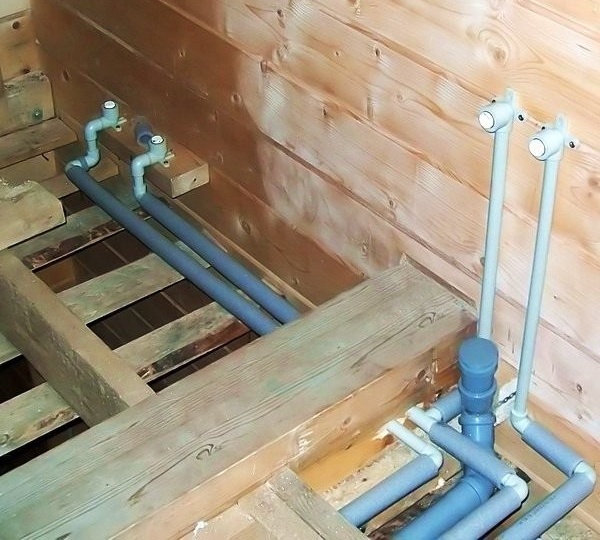
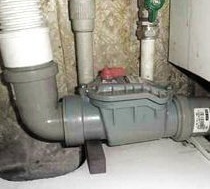
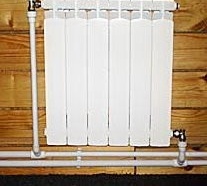
2 comments